Gypenosides improves nonalcoholic fatty liver disease induced by high-fat diet induced through regulating LPS/TLR4 signaling pathway
- PMID: 33121337
- PMCID: PMC7714522
- DOI: 10.1080/15384101.2020.1829800
Gypenosides improves nonalcoholic fatty liver disease induced by high-fat diet induced through regulating LPS/TLR4 signaling pathway
Abstract
Background The contents of lipopolysaccharide (LPS) and Toll-like receptor 4 (TLR4) are significantly increased during the progression of nonalcoholic fatty liver disease (NAFLD). The study investigated the role of the LPS/TLR4 signaling pathway in improving gypenosides (Gyp) on NAFLD. Methods NAFLD model were established in rats and treated by Gyp. Pathological changes of liver tissues were observed by Hematoxylin and Eosin (HE) staining. Lipid metabolism and insulin resistance were measured. Expressions of inflammatory factors and protein of LPS/TLR4 downstream pathway were detected by qRT-PCR and Western blotting. THLE-2 cells were treated by free-fatty acid (FFA), Gyp, and LPS, and then transfected with TLR4. Next, cell viability was detected by MTT. Lipid droplet deposition and Triglyceride (TG) content were determined by Oil Red O staining and ELISA. Results Gyp protected fatty liver tissues in NAFLD model, and significantly reversed cholesterol increased by high-fat diet. Moreover, Gyp increased SOD content and decreased the contents of AST, ALT, MDA, HSI, FBG, FINS, HOMA-IR, IL-1β, and TNF-α, and promoted the expressions of TLR4, LPS, MyD88, p-IκBα, and reduced the expressions of p-p65 and IκBα in the NAFLD model. Gyp treatment significantly reduced lipid droplet deposition, increased TG content and MyD88, p-IκBα, p-p65 in FFA-induced liver cells, but LPS and TLR4 greatly reversed improvement of FFA by Gyp. Conclusion Gypenosides could improve liver function, lipid metabolism, insulin resistance, and levels of inflammatory factors in NAFLD model by regulating LPS/TLR4 signaling pathway in vitro and in vivo.
Keywords: Gypenosides; LPS/TLR4 signaling pathway; insulin resistance; lipid metabolism; nonalcoholic fatty liver disease.
Conflict of interest statement
No potential conflict of interest was reported by the authors.
Figures




Similar articles
-
Kangtaizhi Granule Alleviated Nonalcoholic Fatty Liver Disease in High-Fat Diet-Fed Rats and HepG2 Cells via AMPK/mTOR Signaling Pathway.J Immunol Res. 2020 Aug 20;2020:3413186. doi: 10.1155/2020/3413186. eCollection 2020. J Immunol Res. 2020. PMID: 32884949 Free PMC article.
-
Berberine inhibits liver damage in rats with non-alcoholic fatty liver disease by regulating TLR4/MyD88/NF-κB pathway.Turk J Gastroenterol. 2020 Dec;31(12):902-909. doi: 10.5152/tjg.2020.19568. Turk J Gastroenterol. 2020. PMID: 33626003 Free PMC article.
-
Regulatory effect of a Chinese herbal medicine formula on non-alcoholic fatty liver disease.World J Gastroenterol. 2019 Sep 14;25(34):5105-5119. doi: 10.3748/wjg.v25.i34.5105. World J Gastroenterol. 2019. PMID: 31558860 Free PMC article.
-
Alleviation of non-alcoholic fatty liver disease by Huazhi Fugan Granules is associated with suppression of TLR4/NF-κB signaling pathway.Clin Investig Arterioscler. 2021 Sep-Oct;33(5):257-266. doi: 10.1016/j.arteri.2020.12.007. Epub 2021 Mar 31. Clin Investig Arterioscler. 2021. PMID: 33810882 Review. English, Spanish.
-
Role of Hedgehog Signaling Pathway in NASH.Int J Mol Sci. 2016 Jun 1;17(6):857. doi: 10.3390/ijms17060857. Int J Mol Sci. 2016. PMID: 27258259 Free PMC article. Review.
Cited by
-
Anti-Inflammatory Effects and Mechanisms of Dandelion in RAW264.7 Macrophages and Zebrafish Larvae.Front Pharmacol. 2022 Aug 25;13:906927. doi: 10.3389/fphar.2022.906927. eCollection 2022. Front Pharmacol. 2022. PMID: 36091818 Free PMC article.
-
Protective effects of lipid emulsion on vital organs through the LPS/TLR4 pathway in acute organophosphate poisoning.BMC Pharmacol Toxicol. 2025 Mar 27;26(1):71. doi: 10.1186/s40360-025-00904-4. BMC Pharmacol Toxicol. 2025. PMID: 40148919 Free PMC article.
-
Effect of the total flavonoids of Dracocephalum moldavica L. on metabolic associated fatty liver disease in rats.Front Pharmacol. 2025 May 15;16:1549515. doi: 10.3389/fphar.2025.1549515. eCollection 2025. Front Pharmacol. 2025. PMID: 40444056 Free PMC article.
-
Bioinformatics based exploration of the anti-NAFLD mechanism of Wang's empirical formula via TLR4/NF-κB/COX2 pathway.Mol Med. 2024 Dec 27;30(1):278. doi: 10.1186/s10020-024-01022-3. Mol Med. 2024. PMID: 39730994 Free PMC article.
-
Gypenosides ameliorate ductular reaction and liver fibrosis via inhibition of hedgehog signaling.Front Pharmacol. 2022 Nov 22;13:1033103. doi: 10.3389/fphar.2022.1033103. eCollection 2022. Front Pharmacol. 2022. PMID: 36483737 Free PMC article.
References
-
- Chakravarthy MV, Waddell T, Banerjee R, et al. Nutrition and nonalcoholic fatty liver disease: current perspectives. Gastroenterol Clin North Am. 2020;49(1):63–94. - PubMed
-
- Tang XR, Wang JX, Fu L, et al. Effects of total flavonoids in astragali complanati semen on liver lipid level and ERalpha expression on liver in hyperlipidemia rats with kidney-Yang deficiency pattern. Zhongguo Zhong Yao Za Zhi. 2018;43:2365–2371. - PubMed
-
- Kiziltas S, Ata P, Colak Y, et al. TLR4 gene polymorphism in patients with nonalcoholic fatty liver disease in comparison to healthy controls. Metab Syndr Relat Disord. 2014;12(3):165–170. - PubMed
Publication types
MeSH terms
Substances
LinkOut - more resources
Full Text Sources
Medical
Miscellaneous
